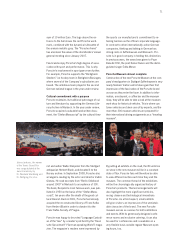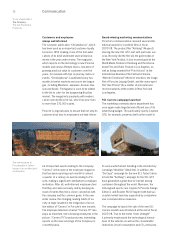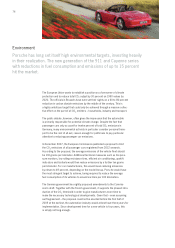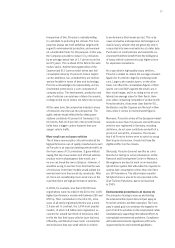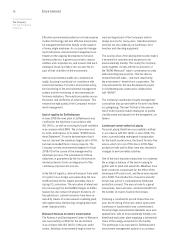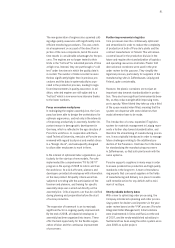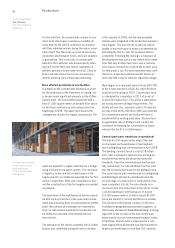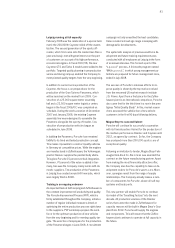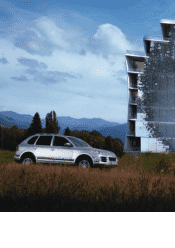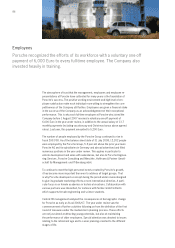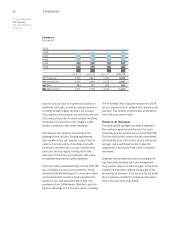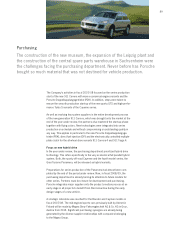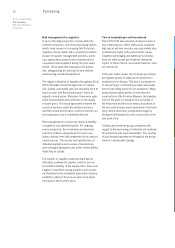Porsche 2007 Annual Report Download - page 84
Download and view the complete annual report
Please find page 84 of the 2007 Porsche annual report below. You can navigate through the pages in the report by either clicking on the pages listed below, or by using the keyword search tool below to find specific information within the annual report.The new generation of engines also spawned cutt-
ing edge quality assurance with significantly more
efficient monitoring procedures. This was a tech-
nical requirement on account of the direct fuel in-
jection of the new components, but at the same
time results in considerable advantages for the pro-
cess. The engines are no longer tested to their
limits in the “hot test” for extended periods of time
at high revs. Instead, they are put through a “cold
test” under low stress in which the quality data is
recorded. The number of data recorded is never-
theless significantly higher than in previous pro-
cedures and this data is systematically incorpo-
rated in the production process, leading to signi-
ficant improvements in quality assurance. In ad-
dition, selected engines are still subjected to a
“hot test” which is now even more intensive thanks
to the lower numbers.
Focus on modern workplaces
In redesigning the engine assembly line, the Com-
pany has been able to design the workstations for
optimum ergonomics, and not only in the interests
of improving productivity in assembly. Another im-
portant reason is demographic development in
Germany, which is reflected in the age structure of
Porsche’s workforce. In cooperation with Darm-
stadt Technical University, new jobs at Porsche are
reviewed with regard to physical and mental stress
in a “design check”, and subsequently designed
to allow older employees to work in them.
In the interest of optimized labor organization, par-
ticularly for the start-up of new models, Porsche
implemented the comprehensive “Fit für 997 II”
program in the spring of 2008 to inform and train
the workforce. At a kick-off event, planners and
developers provided all employees with information
on the new product. All quality criteria were then
subjected to testing with the participation of the
foremen and planners, and training for specific
assembly steps was carried out directly on the
assembly line. Critical aspects can thus be clarified
during planning and preparation before the start
of series production.
The expansion of teamwork is an increasingly
significant factor in ongoing quality improvement.
By the end of 2008, all industrial employees in
assembly had been organized into teams. These
offer the best opportunity for the flexible organi-
zation of labor and the continuous improvement
of processes.
Further improvements in logistics
Core processes must be continuously optimized
and streamlined in order to reduce the complexity
of production at both of Porsche’s plants and the
contract manufacturer in Finland. This will remain
a central issue for the production division in the
future and requires the standardization of logistics
and operating resources at all sites. Plastic fold
able universal containers were used in the year
under review for this purpose. They simplify the
logistical process, particularly for suppliers of the
manufacturing sites in Zuffenhausen, Leipzig and
Finland, quite considerably.
However, the plastic containers are not just an
important step towards standardization in produc-
tion. They also have significant environmental bene-
fits, as they reduce weight while improving trans-
port capacity. When folded they take up only a third
of the space needed when filled, meaning that the
system can dispense with some deliveries that
would otherwise have to be made.
The introduction of a new, expanded IT logistics
system for materials management in Leipzig repre-
sents a further step toward standardization, and
therefore the streamlining of manufacturing proces-
ses. It was originally introduced in order to manage
future challenges relating to the additional pro-
duction of the Panamera. It will also form the basis
for standardizing the manufacturing processes
in Zuffenhausen, so that both plants work with the
same systems.
Porsche supports suppliers in many ways in order
to ensure problem-free production and high quality
standards in the long term. A team of manufactu-
ring experts that can assist suppliers in the fields
of manufacturing and delivery is in place to enable
swift remedial action for any deficits with a mini-
mum of red tape.
Utterly reliable delivery dates
With a view to optimizing order processing, the
Company introduced a planning and order proces-
sing system for dealers and importers in the year
under review based on the “PIA” process (Porsche
Integrated Order Management). Initial solutions
were implemented in China and Russia at the end
of 2007, and the newly-established subsidiary in
Switzerland has been using the entire system since
June 2008 as a pilot project.
81


